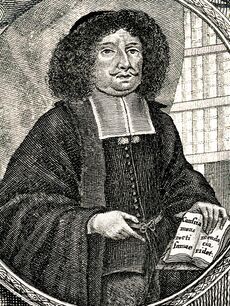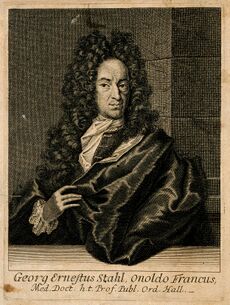نظرية الاحتراق

نظرية الفلوجستون phlogiston theory هي superseded scientific theory that postulated the existence of a fire-like element called phlogiston ( /flɒˈdʒɪstən,_floʊʔ,_ʔɒn/)[1][2] contained within combustible bodies and released during combustion. The name comes from the Ancient Greek φλογιστόν phlogistón (burning up), from φλόξ phlóx (flame). The idea was first proposed in 1667 by Johann Joachim Becher and later put together more formally by Georg Ernst Stahl. Phlogiston theory attempted to explain chemical processes such as combustion and rusting, now collectively known as oxidation. It was challenged by the concomitant weight increase and was abandoned before the end of the 18th century following experiments by Antoine Lavoisier and others. Phlogiston theory led to experiments that ultimately concluded with the discovery of oxygen.
. . . . . . . . . . . . . . . . . . . . . . . . . . . . . . . . . . . . . . . . . . . . . . . . . . . . . . . . . . . . . . . . . . . . . . . . . . . . . . . . . . . . . . . . . . . . . . . . . . . . . . . . . . . . . . . . . . . . . . . . . . . . . . . . . . . . . . . . . . . . . . . . . . . . . . . . . . . . . . . . . . . . . . . .
النظرية
كان الاعتقاد السائد في القرن السابع عشر أن المواد تحترق لأنها تحتوي على مادة بداخلها أطلق عليها الفلوجستون تخرج عند الاحتراق , أما المواد التي لا تحترق فلا تحتوي على الفلوجستون ولم يكن لافوزاييه من الذين أقتنعوا بذلك , ويشاركه الرأي العالم بريستلي , فقام لافوزاييه بتجاربه بواسطة ناقوس ومعوجة فسخن كمية من الزئبق لمدة 12 يوم فلاحظ نقصان الزئبق حتى تحول إلى مسحوق الزئبق الأحمر (كلس الزئبق ) ولاحظ كذلك نقصان حجم الهواء داخل الناقوس والمعوجة بمقدار خمس من حجم الهواء داخل الناقوس والمعوجة وقد علل لافوزاييه ذلك أن الجزء الذي نقص من الهواء قد اتحد بطريقة ما مع الزئبق وكون المسحوق الأحمر وبذلك توصل لافوزاييه من هذه النتائج إلى تفسير جديد لعملية الاحتراق وهو أن الاحتراق اتحاد كيميائي بين المادة المحترقة وبين هذه الغازات اللتي أطلق عليها اسم الأكسجين.
التاريخ
Empedocles had formulated the classical theory that there were four elements—water, earth, fire, and air—and Aristotle reinforced this idea by characterising them as moist, dry, hot, and cold. Fire was thus thought of as a substance, and burning was seen as a process of decomposition that applied only to compounds. Experience had shown that burning was not always accompanied by a loss of material, and a better theory was needed to account for this.[3]
Johann Joachim Becher
In 1667, Johann Joachim Becher published his book Physica subterranea, which contained the first instance of what would become the phlogiston theory. In his book, Becher eliminated fire and air from the classical element model and replaced them with three forms of the earth: terra lapidea, terra fluida, and terra pinguis.[4][5] Terra pinguis was the element that imparted oily, sulphurous, or combustible properties.[6] Becher believed that terra pinguis was a key feature of combustion and was released when combustible substances were burned.[4] Becher did not have much to do with phlogiston theory as we know it now, but he had a large influence on his student Stahl. Becher's main contribution was the start of the theory itself, however much of it was changed after him.[7] Becher's idea was that combustible substances contain an ignitable matter, the terra pinguis.[8]
گيورگ إرنست شتال
In 1703 Georg Ernst Stahl, a professor of medicine and chemistry at Halle, proposed a variant of the theory in which he renamed Becher's terra pinguis to phlogiston, and it was in this form that the theory probably had its greatest influence.[9] The term 'phlogiston' itself was not something that Stahl invented. There is evidence that the word was used as early as 1606, and in a way that was very similar to what Stahl was using it for.[7] The term was derived from a Greek word meaning inflame. The following paragraph describes Stahl's view of phlogiston:
To Stahl, metals were compounds containing phlogiston in combination with metallic oxides (calces); on ignition, the phlogiston was freed from the metal leaving the oxide behind. When the oxide was heated with a substance rich in phlogiston, such as charcoal, the calx again took up phlogiston and regenerated the metal. Phlogiston was a definite substance, the same in all its combinations.[8]
Stahl's first definition of phlogiston first appeared in his Zymotechnia fundamentalis, published in 1697. His most quoted definition was found in the treatise on chemistry entitled Fundamenta chymiae in 1723.[7] According to Stahl, phlogiston was a substance that was not able to be put into a bottle but could be transferred nonetheless. To him, wood was just a combination of ash and phlogiston, and making a metal was as simple as getting a metal calx and adding phlogiston.[8] Soot was almost pure phlogiston, which is why heating it with a metallic calx transforms the calx into the metal and Stahl attempted to prove that the phlogiston in soot and sulphur were identical by converting sulphates to liver of sulphur using charcoal. He did not account for the increase in weight on combustion of tin and lead that were known at the time.[10]
J. H. Pott
Johann Heinrich Pott, a student of one of Stahl's students, expanded the theory and attempted to make it much more understandable to a general audience. He compared phlogiston to light or fire, saying that all three were substances whose natures were widely understood but not easily defined. He thought that phlogiston should not be considered as a particle but as an essence that permeates substances, arguing that in a pound of any substance, one could not simply pick out the particles of phlogiston.[7] Pott also observed the fact that when certain substances are burned they increase in mass instead of losing the mass of the phlogiston as it escapes; according to him, phlogiston was the basic fire principle and could not be obtained by itself. Flames were considered to be a mix of phlogiston and water, while a phlogiston-and-earthy mixture could not burn properly. Phlogiston permeates everything in the universe, it could be released as heat when combined with an acid. Pott proposed the following properties:
- The form of phlogiston consists of a circular movement around its axis.
- When homogeneous it cannot be consumed or dissipated in a fire.
- The reason it causes expansion in most bodies is unknown, but not accidental. It is proportional to the compactness of the texture of the bodies or to the intimacy of their constitution.
- The increase of weight during calcination is evident only after a long time, and is due either to the fact that the particles of the body become more compact, decrease the volume and hence increase the density as in the case of lead, or those little heavy particles of air become lodged in the substance as in the case of powdered zinc oxide.
- Air attracts the phlogiston of bodies.
- When set in motion, phlogiston is the chief active principle in nature of all inanimate bodies.
- It is the basis of colours.
- It is the principal agent in fermentation.[7]
Pott's formulations proposed little new theory; he merely supplied further details and rendered existing theory more approachable to the common man.
غيرهم
Johann Juncker also created a very complete picture of phlogiston. When reading Stahl's work, he assumed that phlogiston was in fact very material. He, therefore, came to the conclusion that phlogiston has the property of levity, or that it makes the compound that it is in much lighter than it would be without the phlogiston. He also showed that air was needed for combustion by putting substances in a sealed flask and trying to burn them.[7]
Guillaume-François Rouelle brought the theory of phlogiston to France, and he was a very influential scientist and teacher so it gained quite a strong foothold very quickly. Many of his students became very influential scientists in their own right, Lavoisier included.[8] The French viewed phlogiston as a very subtle principle that vanishes in all analysis, yet it is in all bodies. Essentially they followed straight from Stahl's theory.[7]
Giovanni Antonio Giobert introduced Lavoisier's work in Italy. Giobert won a prize competition from the Academy of Letters and Sciences of Mantua in 1792 for his work refuting phlogiston theory. He presented a paper at the Académie royale des Sciences of Turin on 18 March 1792, entitled Examen chimique de la doctrine du phlogistique et de la doctrine des pneumatistes par rapport à la nature de l'eau ("Chemical examination of the doctrine of phlogiston and the doctrine of pneumatists in relation to the nature of water"), which is considered the most original defence of Lavoisier's theory of water composition to appear in Italy.[12]
انظر أيضاً
المراجع
- ^ Wells, John C. (2008). Longman Pronunciation Dictionary (3rd ed.). Longman. ISBN 978-1-4058-8118-0.
- ^ Mauskop, Seymour (1 November 2002). "Richard Kirwan's Phlogiston Theory: Its Success and Fate". Ambix. 49 (3): 185–205. doi:10.1179/amb.2002.49.3.185. ISSN 0002-6980. PMID 12833914. S2CID 170853908.
- ^ Ladenburg, Dr. A (1911). Lectures on the History of Chemistry. University of Chicago Press. p. 4. Retrieved 26 August 2016.
- ^ أ ب Bowler, Peter J (2005). Making modern science: A historical survey. Chicago: University of Chicago Press. p. 60. ISBN 9780226068602.
- ^ Becher, Physica Subterranea p. 256 et seq.
- ^ Brock, William Hodson (1993). The Norton history of chemistry (1st American ed.). New York: W. W. Norton. ISBN 978-0-393-03536-0.
- ^ أ ب ت ث ج ح خ White, John Henry (1973). The History of Phlogiston Theory. New York: AMS Press Inc. ISBN 978-0404069308.
- ^ أ ب ت ث Leicester, Henry M.; Klickstein, Herbert S. (1965). A Source Book in Chemistry. Cambridge, Massachusetts: Harvard University Press.
- ^ Mason, Stephen F., (1962). A History of the Sciences (revised edition). New York: Collier Books. Ch. 26.
- ^ Ladenburg 1911, pp. 6–7.
- ^ "Chemistry", Encyclopedia Britannica, 1911
- ^ Abbri, Ferdinando (2001). "GIOBERT, Giovanni Antonio". Dizionario Biografico degli Italiani [Biographical Dictionary of the Italians]. 55. Retrieved 15 September 2017.
External links
 Quotations related to نظرية الاحتراق at Wikiquote
Quotations related to نظرية الاحتراق at Wikiquote

